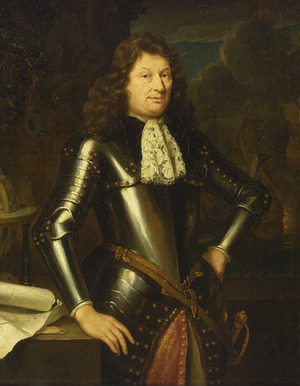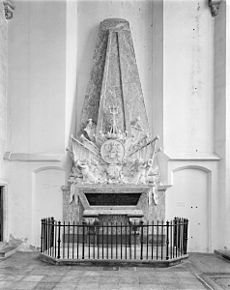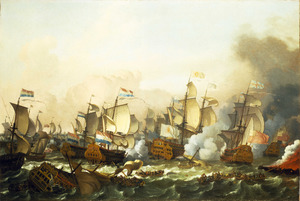Philips van Almonde facts for kids
Quick facts for kids
Philips van Almonde
|
|
|---|---|

Portrait of Almonde
|
|
| Born | December 29, 1644 Den Briel, Dutch Republic |
| Died | October 8, 1711 (aged 67) Oegstgeest, Dutch Republic |
| Allegiance | |
| Service | Navy |
| Years of service | 1661 to 1711 |
| Rank | Lieutenant-admiral |
| Wars | |

Philips van Almonde (born December 29, 1644 – died January 6, 1711) was a brave Dutch Lieutenant Admiral. He served in the Dutch navy during many important sea battles in the late 1600s and early 1700s. He helped protect his country during several major wars.
Contents
Philips was born in a town called Den Briel in the Dutch Republic. His father, Pieter Jansz van Almonde, was a wealthy citizen. Philips learned about sailing and naval life from his uncle, Jacob Cleidijck, who was a frigate commander.
In 1661, Philips started his naval career as a cadet on his uncle's ship, the Wapen van Dordrecht. By 1664, he was made a lieutenant by the Admiralty of the Maze, which was a Dutch naval administration.
First Battles and Promotions
Philips van Almonde quickly showed his courage. During the Second Anglo-Dutch War, in the Battle of Lowestoft in 1665, his uncle was injured. Philips bravely took command of the ship. Because of his actions, he was officially confirmed as commander on August 14.
He also fought with distinction in the Four Days Battle in June 1666. In this huge battle, the famous Dutch Lieutenant-Admiral Michiel de Ruyter defeated a British fleet. In 1667, Philips was promoted to a full captain. By 1671, he was captain of the ship Harderwijk.
Rising Through the Ranks
On October 6, 1673, during the Third Anglo-Dutch War, Philips van Almonde was made a Rear-Admiral. He earned this promotion after showing great skill as captain of the Wassenaer in the Battle of Solebay. He also commanded the Delft during the Battle of Schooneveld and the Battle of Texel.
In 1674, Van Almonde sailed on the ship Ridderschap van Holland. He led attacks against the French along their western coast. The next year, he joined a squadron led by Admiral Cornelis Tromp in the Mediterranean Sea.
Battles in the Baltic Sea
In 1676, Philips van Almonde commanded a group of ships during the battles of Bornholm and Öland in the Baltic Sea. He was part of a combined Danish-Dutch fleet. In the Battle of Öland, the Swedish navy, which had more ships, was soundly defeated. This victory gave naval control to Denmark.
Later in 1676, after Admiral De Ruyter passed away, Van Almonde led the Dutch fleet from the Mediterranean back to Holland. On April 5, 1684, he was promoted to Vice-Admiral. During the Glorious Revolution, he commanded the rear part of William III of Orange's fleet when they invaded England.

Major Victories and Later Career
Philips van Almonde became most famous during the Nine Years' War (also called the War of the Grand Alliance). In this war, the Netherlands and its allies fought against France. On March 28, 1692, he was promoted to Lieutenant-Admiral.
Battle of La Hougue
Van Almonde, on his ship De Prins, commanded a squadron in the Battle of La Hougue (also known as the Battle of Barfleur) on May 29, 1692. He helped Admiral Edward Russell win a big victory over the French fleet. Van Almonde used his smaller long boats to attack the trapped French ships, helping to destroy them.
Battle of Vigo Bay
In 1702, during the War of the Spanish Succession, Van Almonde came up with a plan to capture Spanish treasure ships. These ships were arriving from the West Indies loaded with riches. On October 23, he convinced English Admiral Sir George Rooke to attack these treasure ships. This was a risky move because it was late in the year, and French warships were protecting the Spanish ships.
The Dutch and English forces attacked in the Battle of Vigo Bay. They destroyed the enemy fleet in the harbor of Vigo. The English captured four warships and six treasure ships. The Dutch took six warships and five treasure ships, though the treasure had been unloaded just before the attack.
In 1706, Van Almonde stepped down from commanding the Dutch fleet heading to Portugal. This was because he would have been under the command of a less senior English admiral. On December 20, 1708, he was transferred back to his old naval office, the Admiralty of the Maze in Rotterdam. This was considered the most honorable position in the Dutch fleet.
Final Years
Philips van Almonde later moved back to his estate called Haaswyk in Oegstgeest, near Leyden. He passed away there on January 6, 1711. His memorial stands in the Katherine Church in Briel, where he was buried on December 30, 1712.

